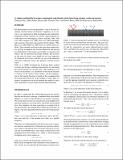A robust method for fracture orientation and density detection from seismic scattered energy
Author(s)
Fang, Xinding; Fehler, Michael; Zhu, Zhenya; Chen, Tianrun; Burns, Daniel R.
DownloadFang_fracture_properties.pdf (409.6Kb)
Other Contributors
Massachusetts Institute of Technology. Earth Resources Laboratory
Metadata
Show full item recordAbstract
The measurements of fracture parameters, such as fracture orientation, fracture density and fracture compliance, in a reservoir is very important for field development and exploration. Traditional seismic methods for fracture characterization include shear wave birefringence (Gaiser and Dok, 2001; Dok et al., 2001; Angerer et al., 2002; Vetri et al., 2003) and amplitude variations with offset and azimuth (AVOA) (Ruger, 1998; Shen et al., 2002; Hall et al., 2003; Liu et al., 2010; Lynn et al., 2010). These methods are based on the equivalent medium theory with the assumption that fracture dimension and spacing are small relative to the seismic wave length, so a fracture zone behaves like an equivalent anisotropic medium. But fractures on the order of seismic wave length are also very important for enhanced oil recovery, and they are one of the important subsurface scattering sources that generate scattered seismic waves. Willis et al. (2006) developed the Scattering Index method to extract the fracture scattering characteristics by calculating the transfer funtion of a fracture zone. This method has two sources of uncertainty: (1) calculation of the transfer function is sensitive to the analysis time window; (2) the interpretation of the transfer function is based on the assumption that the background reflectivity of the medium is white. Here we propose a modification of the SI methods that addresses these issues and leads to a more robust fracture characterization.
Date issued
2011Publisher
Massachusetts Institute of Technology. Earth Resources Laboratory
Series/Report no.
Earth Resources Laboratory Industry Consortia Annual Report;2011-04